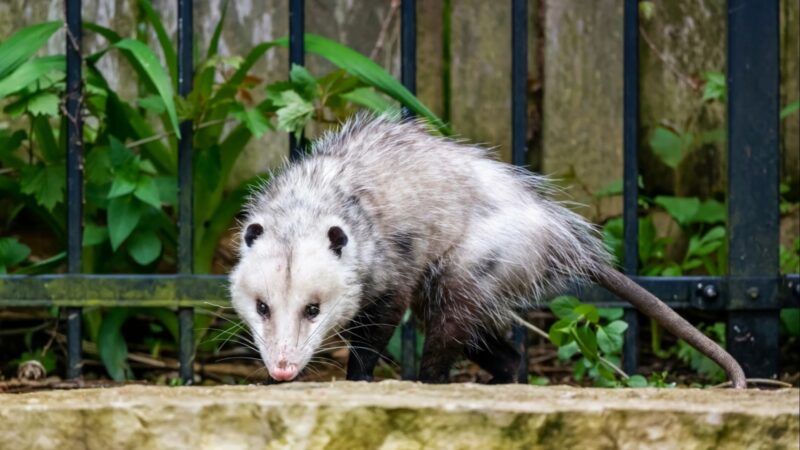Winter presents a big challenge for wildlife, with freezing temperatures and scarce food sources testing the survival skills of many species. Among these resilient survivors are opossums, North America’s only marsupial.
These creatures have adapted in remarkable ways to withstand the cold and find sustenance during the winter months. Today we’ll talk about the fascinating strategies they employ to survive the harsh conditions of winter.
Key Takeaways
- Opossums adapt to cold weather through behavioral changes like finding shelter in diverse places (including urban environments), entering a state of torpor to conserve energy, and adjusting their nocturnal activities to stay warm.
- They have an opportunistic and varied diet that includes fruits, grasses, insects, small rodents, and carrion.
- They have unique defenses against predators, including their ability to play dead (thanatosis) and their immunity to the venom of most snakes found in their habitat, allowing them to turn potential predators into prey.
- Despite challenges like high mortality rates among the young and the threat of predators, opossums’ survival strategies like seeking shelter, slowing down metabolism, and having a broad diet ensure their survival and contribution to ecosystem health.
Adapting to the Cold
Opossums, with their thin fur and bare tails, might seem ill-equipped for cold weather. However, they have several adaptations that help them cope with the chill. Their fur, although not as thick as some other mammals, still provides insulation against the cold.
Additionally, they can adjust their behavior, becoming more nocturnal to take advantage of the slightly warmer night temperatures. Their ability to adapt their feeding habits also plays a critical role in their survival during the colder months.
Seeking Suitable Shelter
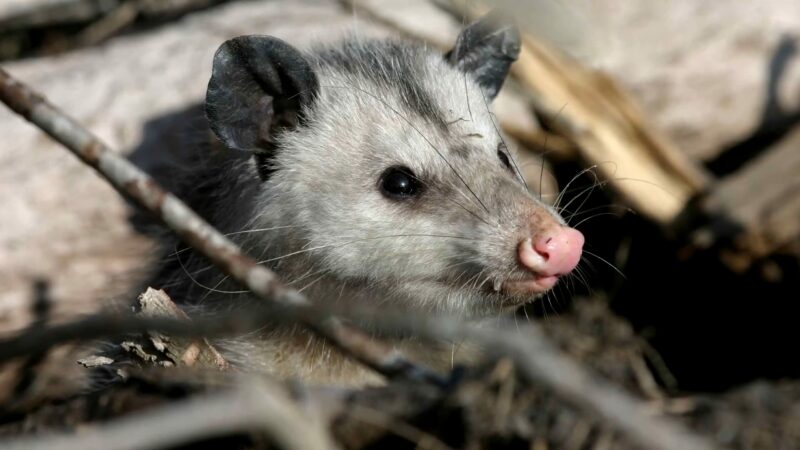
One key survival strategy is finding suitable shelter. Opossums are not picky about where they bunk down for the winter. They will make do with whatever is available, from hollow logs and tree cavities to abandoned burrows of other animals.
In urban areas, they may even nest in garages or under houses. These shelters provide protection from the elements and predators. Moreover, by nesting in close proximity to human habitats, they can sometimes benefit from artificial heat sources.
Opossums also use leaves, grass, and other materials to insulate their nests, which helps keep them warm during the winter months. This ability to utilize a variety of shelters enables them to survive in diverse environments.
Slowing Down
Opossums don’t hibernate but they do enter a state of torpor. Torpor is a temporary drop in metabolic rate, which allows the opossum to conserve energy. During particularly cold spells, an opossum might become lethargic, reducing its activity level significantly to save energy and survive on less food.
This state can be particularly beneficial during the coldest parts of winter, as it reduces the need for foraging, which can be risky and energy-consuming. The flexibility of this torpor state, not being a deep hibernation, allows them to react quickly to changes in temperature or potential threats.
Finding Food
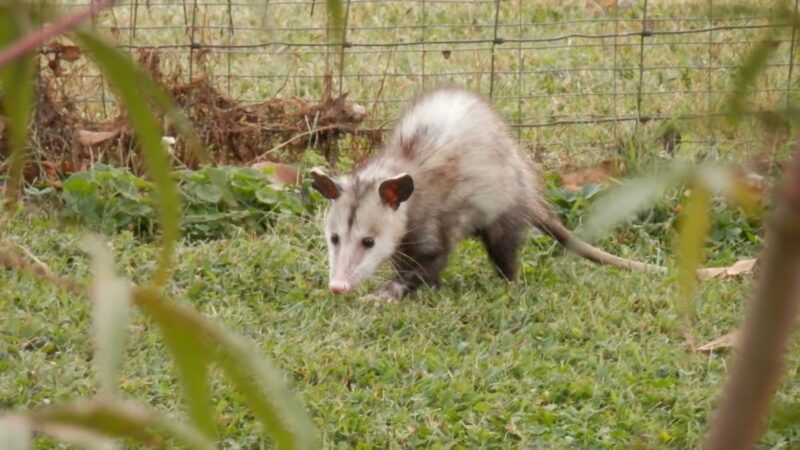
Winter scarcity forces opossums to be less picky about their diet. They are opportunistic feeders and will eat a wide variety of foods. Their diet’s flexibility ensures they can make the most of available resources, reducing competition with other animals.
By consuming pests and carrion, they play an essential role in their ecosystem, even in urban settings. This adaptability in the diet is a key factor in their survival strategy, enabling them to withstand the scarcity of traditional food sources during winter.
Just as opossums adjust their feeding habits, the red foxes also adapt, employing unique strategies to find food and stay warm during the cold months.
What Do They Eat?
Opossums’ diet includes fruits, grasses, insects, small rodents, and even carrion. This varied diet helps them find food even when resources are limited. In urban and suburban areas, opossums may also rummage through trash cans or compost bins in search of a meal.
Their omnivorous nature allows them to adjust their diet based on availability, making them highly adaptable to changing conditions. This dietary flexibility is crucial for their survival, especially during the winter months when food is scarce.
Fat Storage
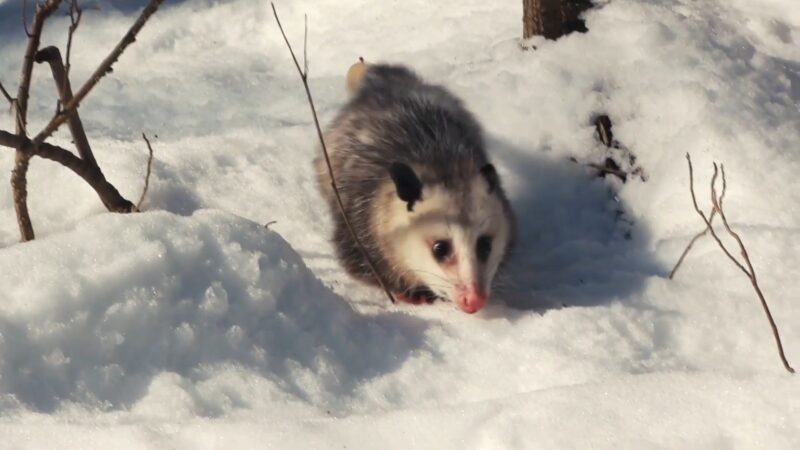
In the fall, opossums eat more to gain weight, storing fat that will help sustain them through the winter. This fat reserve is crucial for their survival during periods when food is scarce.
The ability to store fat not only helps them maintain body heat but also provides a vital energy reserve that they can draw on when food is not readily available. This strategy demonstrates the opossum’s remarkable ability to prepare for the harsh winter months ahead.
How Do They Cope with Predators and Threats?
Winter not only brings the challenge of cold and hunger but also increases vulnerability to predators. Opossums have unique defenses to cope with these threats. Their solitary nature and nocturnal habits help minimize encounters with predators.
Additionally, their ability to play dead and their resistance to venom provide them with unique survival mechanisms that many other small mammals lack.
Playing Dead
Opossums are famous for “playing dead” as a defense mechanism. When threatened, they can enter a catatonic state that can last for hours, convincing predators that they are not a viable meal. This behavior, known as thanatosis, can be a life-saving strategy.
This remarkable defense mechanism is highly effective, deterring would-be predators who prefer live prey. It highlights the opossum’s unique adaptations for survival, which extend beyond physical traits to include behavioral strategies.
Resistance to Venom
Interestingly, opossums are immune to the venom of most snakes found in their habitat, including rattlesnakes and cottonmouths. This resistance allows them to hunt snakes as a food source, turning a potential predator into prey.
This immunity to venom gives opossums a significant advantage in their environment, allowing them to exploit food sources that are dangerous to other animals.
Overcoming Challenges
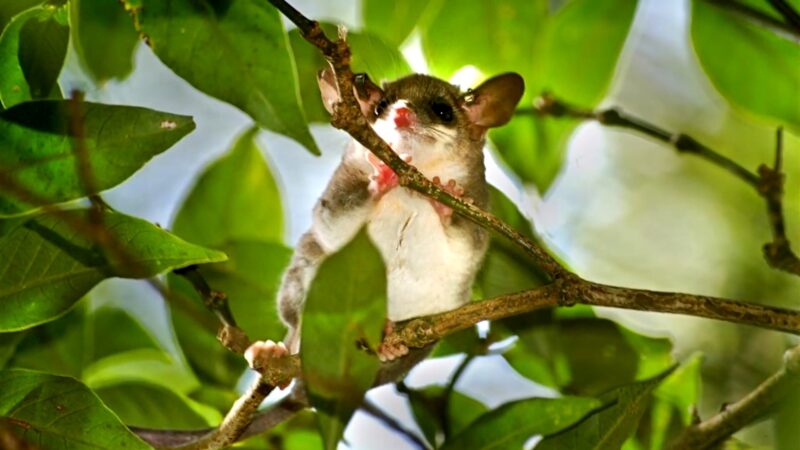
Despite these adaptations, winter is still a tough time for opossums. Their relatively short lifespan (typically only two to four years in the wild) and high mortality rate among young mean that not all opossums will survive the winter.
However, those that do continue to play a crucial role in their ecosystems, acting as scavengers and controlling insect populations. Their resilience and adaptability not only ensure their survival but also contribute to the health and balance of their habitats.
FAQs
Do opossums have any natural predators?
Yes, they face threats from several predators, including owls, coyotes, and foxes.
Can opossums survive in snowy environments?
Yes, they can survive in snowy environments by utilizing their adaptations such as seeking shelter, entering a state of torpor, and relying on their fat reserves.
How do opossums benefit urban environments?
In urban environments, they help control pest populations, including rats and insects, and clean up carrion, thus contributing to sanitation and reducing the spread of disease.
What happens to opossums’ tails in winter?
Their tails can be susceptible to frostbite in extremely cold weather due to their lack of fur, which can lead to tissue damage and loss of the tail tip.
Do opossums migrate to avoid cold weather?
They do not migrate; they adapt to the cold by finding shelter, slowing down their metabolism, and utilizing their fat reserves to survive the winter.
How do opossums interact with other animals during winter?
They are generally solitary animals. During winter, their interactions with other animals are mostly limited to competition for food and shelter, though they may occasionally share dens with other small mammals.
The Bottom Line
Through a combination of behavioral and physiological adaptations, opossums manage to endure the cold months, contributing to the ecological balance. Their ability to thrive in diverse environments, from woodlands to urban areas, underscores their remarkable adaptability.
Related Posts:
- How Do Red Foxes Survive Winter? Survival Guide
- What Sounds Do Opossums Make? - Identify and…
- Discover the 13 Cutest Dinosaurs of All Time!
- Jackpot for the Planet: Discover the Eco-Friendly…
- What Do Weasels Eat? - Diet, Lifestyle, and Adaptations
- Herbivore Teeth - Dental Adaptations for Plant-Based Diets


